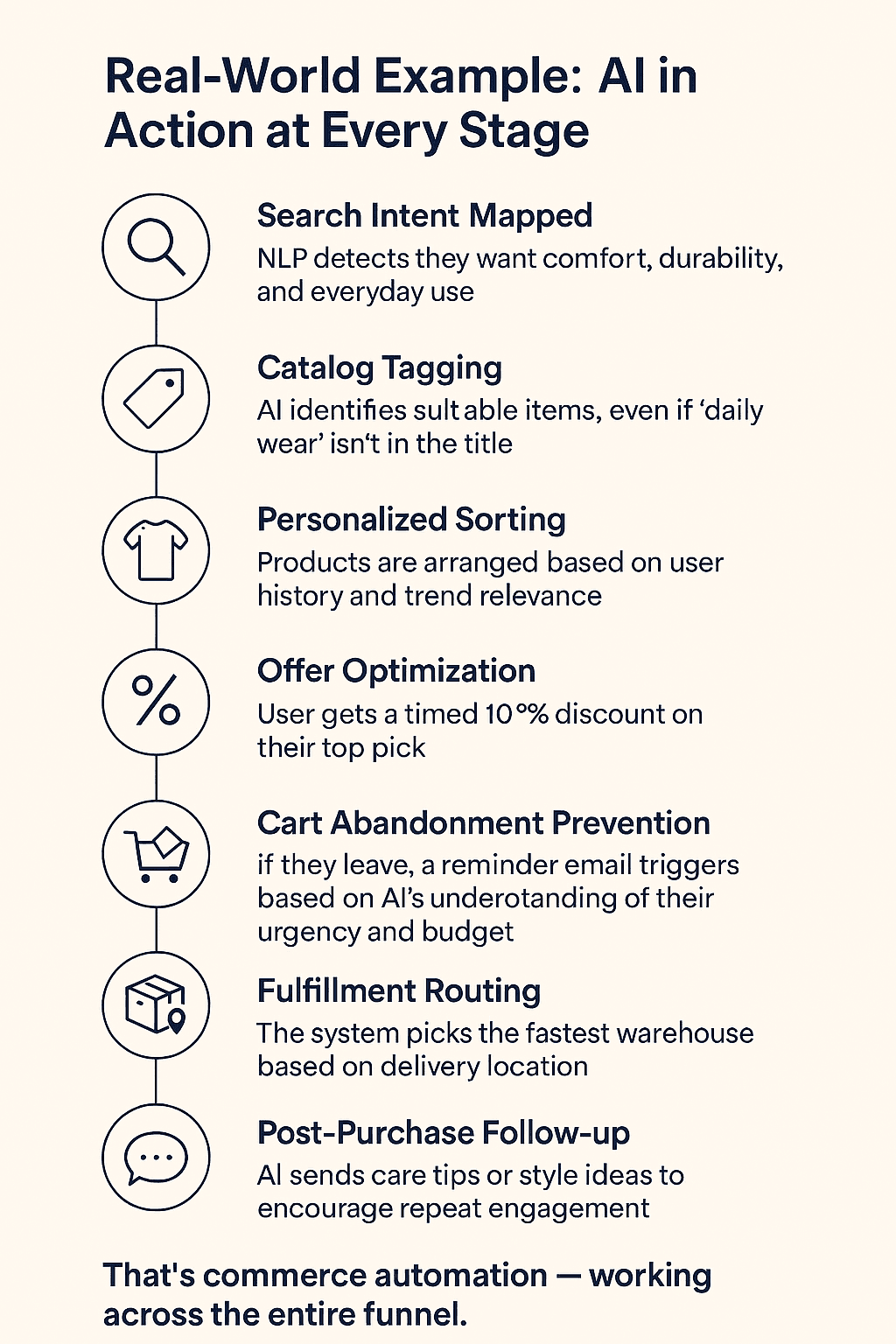Is an AI Style Advisor Better Than a Personal Stylist?
What Is Commerce Automation & How Is It Transforming Retail?


Retail is no longer about just putting products on a shelf — digital or physical. It’s about understanding customer intent, predicting behavior, and delivering instant experiences that feel personal.
Enter commerce automation — the AI-powered engine transforming how brands engage, convert, and retain shoppers in real time. From backend operations to frontend personalization, automation is no longer a nice-to-have. It's becoming the very foundation of every smart AI retail strategy.
Let’s break down how commerce automation is leading this shift — and why it’s quickly becoming the future of retail.
What Is Commerce Automation?
Commerce automation refers to the use of artificial intelligence (AI), machine learning (ML), and data-driven workflows to streamline and optimize every stage of the retail process — from product discovery to fulfillment.
This includes:
- Real-time customer personalization
- Automated product tagging and catalog management
- Inventory and supply chain intelligence
- AI-driven chatbots and virtual assistants
- Dynamic pricing and promotions
- Predictive analytics for demand and behavior
The goal is to move from reactive retail to predictive, intelligent commerce that adapts with every interaction.
Why Traditional Retail Strategy Is Struggling

Shoppers today don’t wait. They expect:
- Personalized recommendations
- 24/7 support
- Seamless checkout
- Real-time inventory visibility
- Hyper-relevant search results
Traditional systems simply can’t keep up. Manual tagging, static promotions, or generic experiences are no longer effective.
That’s where commerce automation becomes essential — because it connects data across every channel and uses AI to respond instantly.
The Rise of AI Agents in Retail
One of the most exciting advancements in AI retail strategy is the use of intelligent AI agents — autonomous systems that work across retail platforms to:
- Understand user intent
- Deliver personalized experiences
- Coordinate backend systems like stock and logistics
- Respond in natural language via chatbots or voice
- Learn and evolve with every interaction
Retailers are deploying these agents in everything from customer service to product discovery. They don’t just answer queries — they solve needs, recommend items, and close the loop between browsing and buying.
5 Ways Commerce Automation Is Transforming Retail

1. Real-Time Personalization
Instead of static homepage banners or generalized sales, commerce automation enables:
- Personalized product displays
- Context-aware offers
- Recommendations based on browsing behavior, past orders, and current trends
This creates dynamic shopping journeys that feel tailor-made.
2. Smarter Inventory & Supply Chain Sync
AI-powered automation helps track:
- Real-time stock levels
- Delivery ETA predictions
- Supplier lead times
- Seasonal demand forecasts
It also automatically suggests restocks or pauses certain campaigns when inventory is low — removing manual guesswork from backend operations.
3. AI-Powered Product Discovery
AI now handles product tagging, visual similarity detection, and natural language search.
Instead of keyword-based search bars, shoppers can now type “comfy airport outfit under 3k” and get results that understand intent, not just keywords. This dramatically improves product discovery and satisfaction.
4. Intelligent Pricing and Promotions
With commerce automation, pricing can now adapt to:
- Time of day
- Customer behavior
- Regional performance
- Stock movement
It also helps brands create hyper-targeted promotions that align with user profiles, increasing conversion and minimizing margin loss.
5. Automated Customer Service at Scale
AI agents and chatbots now handle:
- FAQs and transactional support
- Order tracking
- Return initiation
- Styling advice and fit guidance
These systems improve with time — reducing dependency on human agents while improving satisfaction rates.
Why AI Retail Strategy Is Becoming Standard

An AI retail strategy is no longer futuristic — it’s foundational. According to industry insights:
- Brands using AI-driven commerce report higher AOVs (Average Order Values)
- AI reduces friction and drop-offs in the purchase journey
- Automation improves cross-sell and upsell effectiveness
- CX (customer experience) scores improve with personalization at scale
More importantly, AI helps brands adapt to consumer behavior shifts in real time — something traditional strategies simply can’t do.
Real-World Example: AI in Action at Every Stage

Imagine a user visits your online store looking for “white sneakers for daily wear.” With commerce automation, here’s what happens:
- Search Intent Mapped: NLP detects they want comfort, durability, and everyday use
- Catalog Tagging: AI identifies suitable items, even if “daily wear” isn’t in the title
- Personalized Sorting: Products are arranged based on user history and trend relevance
- Offer Optimization: User gets a timed 10% discount on their top pick
- Cart Abandonment Prevention: If they leave, a reminder email triggers based on AI’s understanding of their urgency and budget
- Fulfillment Routing: The system picks the fastest warehouse based on delivery location
- Post-Purchase Follow-up: AI sends care tips or style ideas to encourage repeat engagement
That’s commerce automation — working across the entire funnel.
The Future of Retail Is Responsive, Not Reactive
As retail evolves, success will depend on how quickly businesses can:
- Interpret real-time customer intent
- Adjust offerings dynamically
- Deliver seamless, multi-channel experiences
Commerce automation allows brands to do all this — efficiently, intelligently, and at scale.
In the coming years, we’ll see:
- Autonomous AI agents managing end-to-end journeys
- Emotion-aware personalization
- Unified data across physical and digital stores
- Retail systems that evolve in sync with each customer
Final Thoughts
Retail isn’t becoming automated — it already is. What matters now is whether your strategy keeps pace.
If you’re still relying on siloed data, manual workflows, or gut-feel marketing, you’re falling behind.
Commerce automation is not just about efficiency. It’s about relevance.
It’s how modern brands build loyalty, drive growth, and stay competitive in a world where the only constant is change.
FAQs
Q1. What is commerce automation in retail?
Commerce automation uses AI and data to streamline and personalize retail processes like product discovery, pricing, support, and fulfillment.
Q2. How does commerce automation help retail brands?
It enables real-time personalization, smarter inventory management, AI-powered search, and faster, more relevant customer service — all at scale.
Q3. Why is AI retail strategy essential today?
An AI retail strategy helps brands adapt faster, connect deeper with customers, and stay ahead of shifting expectations and digital commerce trends.






